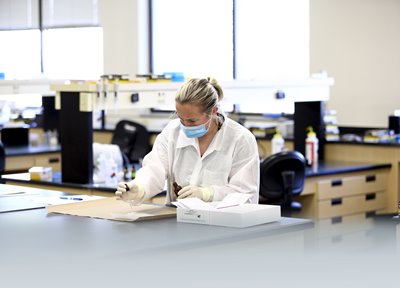 Above: Forensic scientist Nicole Hall is part of BCI’s Laboratory Division, which recently added mitochondrial DNA testing.
Above: Forensic scientist Nicole Hall is part of BCI’s Laboratory Division, which recently added mitochondrial DNA testing.
The Attorney General’s Bureau of Criminal Investigation has made some important changes to better serve its law enforcement partners.
The Cold Case Unit was established last year to help local departments take a fresh look at old, unsolved homicides and sexual assaults. It is a team-driven effort: Each re-examination involves the police department or sheriff ’s office where the case originated as well as members of multiple divisions at BCI. They include:
- Special agents, veteran investigators dedicated solely to the unit.
- Forensic scientists from BCI’s Lab Division, who bring advanced DNA testing and other tools to the table.
- Criminal Intelligence Unit analysts, who establish case evidence and timelines and use investigative genealogy methods to help identify suspects.
“Individually, the Laboratory or Criminal Intelligence or special agents had already been working cold cases for agencies,” said Roger Davis, special agent supervisor and leader of the Cold Case Unit. “But an agent might get called out on an officer-involved shooting, and everything they had done on a cold case would get pushed to the back burner — and rightfully so. The Cold Case Unit gives personnel the opportunity, time and multidisciplinary team to prioritize these cases.”
As part of the initiative, the Laboratory Division has two sexual assault-focused projects through which they reach out to local law enforcement agencies. Project SEND highlights older sexual assault cases in which new technological advancements could mean new leads, and Project SAK highlights cases in which, No. 1, a DNA profile was developed during the bureau’s previous sexual assault evidence kit testing push and, No. 2, additional investigative or laboratory strategies could help bring the perpetrator to justice.
More information is available at
www.OhioAttorneyGeneral.gov/CCU.
In another major development,
the Laboratory Division has brought online mitochondrial DNA testing for use in cases involving missing persons or unidentified remains. This important tool can yield clues in cases where traditional DNA testing fails due to factors such as environmental degradation.
That is because traditional testing analyzes relatively fragile DNA from a cell’s nucleus, which can be easily damaged by environmental factors. But DNA from a cell’s mitochondria is hardier; plus, there might be 100 to 10,000 copies per human cell, compared with the two nuclear DNA copies.
Mitochondrial DNA testing is made possible by a technique called massively parallel sequencing, which allows millions of fragments of DNA from a single sample to be sequenced in unison rather than one at a time. Battelle Memorial Institute worked with BCI to perfect the process.
Ohio’s is just the second state crime lab — after California – to utilize the massively parallel sequencing.
Also in the works are
a pair of technological upgrades that will add power and efficiency to integral BCI-operated systems.
The first will take the
Ohio Law Enforcement Gateway (OHLEG) into its next generation. The system, used by law enforcement agencies statewide, last had a significant update in 2013 and, as a result, had become outdated and fallen behind the FBI’s preferred records management system platform.
“Law enforcement had requested that we add various tools to OHLEG over the years, but we didn’t have the capability or money to do so,” said Jill Small, director of BCI’s OHLEG Division. “Each one would have cost a lot of money. But under the upgrade, we were able to get a lot of those items checked off at one time.”
The new Swift Protect Records Management System offers not only incident reporting but also a complete case management system, specialized crash report module and jail booking component. The system, which also offers additional new tools, was chosen because it is known for being flexible and easy to use.
The second upgrade will bring important efficiencies to the system that supports
Ohio’s Computerized Criminal History database of more than 6 million records, which officers on the street rely on every day.
► Read how the leader of BCI's Identification Division is committed to protecting Ohioans
in this story.
BCI’s Identification Division, which is responsible for cataloging criminal records and running background checks, now uses the 20-year-old Automated Biometric Identification System (ABIS), a combination of the Multi-Biometric Identification System and the criminal history system. But it, too, had fallen behind recommended standards.
The $25 million replacement, called the Ohio Biometric Identification System (OBIS), is set to come online midyear. It will add important system efficiencies and power, creating a more stable tool that retrieves data more rapidly.
The project will fully digitize BCI’s background check service, including turning more than 3 million paper criminal records (containing 12 million documents) into digital records.
Further,
BCI has tweaked its internal structure to ensure units that cross regions of the state, such as the Officer-Involved Critical Incident Response Team and the Crime Scene Unit, are more unified and get the same training. A new Special Victims Unit has brought victim-centered investigations under its umbrella, including crimes against children, child abductions and missing children; human trafficking, both labor and sex; financial or physical abuse of the elderly; and adult sexual assaults.
“We want our organization to reflect the realities of our priority investigations and duties,” said Heinz Von Eckartsberg, assistant superintendent of BCI. “Anything we can do to make sure we work better for our partners — anything we can do to make sure we better protect the people of Ohio — we will do.”